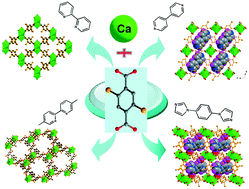Four calcium(ii) coordination polymers based on 2,5-dibromoterephthalic acid and different N-donor organic species: syntheses, structures, topologies, and luminescence properties†
Abstract
By using different N-donor organic species as additional auxiliary ligands with structure-directing roles, four three-dimensional (3D) calcium-based coordination complexes, [Ca(dbt)(H2O)]n1, [Ca(H-dbt)2(5,5′-dmbpy)2]n2, (4,4′-bpy)0.5[Ca(dbt)(H2O)2]n3, and (H2-dib)[Ca3(dbt)4(H2O)4·2H2O]n4 (H2-dbt = 2,5-dibromoterephthalic acid, 2,2′-bpy = 2,2′-bipyridine, 5,5′-dmbpy = 5,5′-dimethyl-2,2′-bipyridine, 4,4′-bpy = 4,4′-bipyridine, dib = 1,4-di(1H-imidazol-1-yl)benzene), have been successfully synthesized under similar solvothermal conditions and structurally characterized. The organic amine molecules play different roles in the formation of four different metal–organic skeletons with diverse structural topologies, in which complexes 1–3 are neutral, and 4 comprises a negatively charged framework with diprotonated dib as the counterion. Complex 1 features a 3D (6,6)-connected framework structure composed of edge-sharing 1D Ca–O–Ca inorganic chains and dbt ligands. The 2,2′-bpy molecule plays an important role in the synthesis of 1 as the structure-directing agent (SDA). Complex 2 shows a 3D 2-fold interpenetrated diamondoid framework (dia, 66) formed by single metal nodes via linear H-dbt anions and bidentate chelating 5,5′-dmbpy ligands, while complex 3 exhibits a 3D noninterpenetrated pcu network with {412·63} topology constructed from binuclear [Ca2(CO2)4] secondary building units and two types of dbt ligands, in which 4,4′-bpy molecules are ordered within the 3D neutral calcium-based framework as template and space filling agents. Complex 4 is a unique (4,4,4,4,5)-connected 5-nodal topology net, in which the diprotonated dib molecules provide space filling to balance the negatively charged framework. In addition, the thermal stability and the fluorescence properties of complexes 1–4 have been investigated.


 Please wait while we load your content...
Please wait while we load your content...